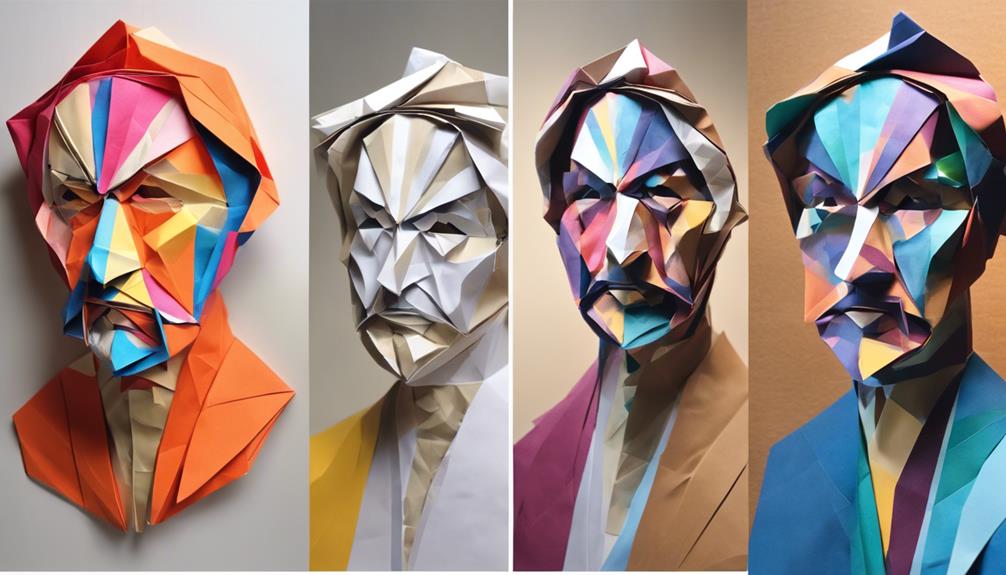Explore contemporary reinterpretations of Hindu gods in art that challenge traditional portrayals. Artists like Manjari Sharma collaborate with Mumbai artisans to infuse modern twists into ancient themes, bridging ancient and modern concepts. Vibrant colors, intricate jewelry, and elaborate details offer profound insights into cultural beliefs in these reimagined paintings. Colonial influences on Indian art, regional variations in painting styles, and the evolution of artistic traditions further enrich the diverse world of Hindu deity representations. These artworks provide unique perspectives that reshape perceptions of divine figures, offering a fresh lens to appreciate the rich tapestry of Hindu artistry.
Key Takeaways
- Modern reinterpretations by artists like Manjari Sharma challenge traditional depictions.
- Vibrant colors and intricate details offer profound cultural insights.
- Colonial Indian art blends Western influences with Hindu iconography.
- Evolution of artistic traditions from Raja Ravi Varma to contemporary artists.
- Regional variations in painting styles showcase diverse artistic expressions.
Unique Depictions of Hindu Deities
Manjari Sharma's Darshan series breathes new life into Hindu deities by collaborating with Mumbai-based artisans to transform models into divine representations. In these unique depictions of Hindu gods and goddesses, traditional Indian paintings are reimagined with a modern twist, showcasing the ongoing relevance of these timeless figures in contemporary art.
Through this collaboration, Sharma's work bridges the gap between the ancient and the modern, offering a fresh perspective on the traditional representations of deities in Indian art.
These innovative portrayals of Hindu gods and goddesses challenge the conventional norms of depicting divinity, inviting viewers to see these iconic figures in a new light. By infusing traditional Indian aesthetics with a contemporary approach, Sharma's Darshan series captures the essence of spiritual symbolism while breathing new life into age-old narratives.
This fusion of the old and the new not only enriches the artistic landscape but also deepens our understanding of the enduring significance of Hindu deities in Indian culture.
Vibrant Colors and Intricate Details

Vibrant colors and intricate details in Hindu god paintings vividly bring deities to life, showcasing the artist's skill and attention to cultural nuances. Indian artists often depict Lord Shiva, a prominent deity in Hindu art, with a mesmerizing array of colors that symbolize various aspects of his divine persona. From the deep blue of his throat to the fiery red of his third eye, each hue holds symbolic significance, conveying emotions and spiritual depth.
The elaborate jewelry adorning Lord Shiva's form in these paintings is meticulously crafted, reflecting the artist's dedication to capturing every intricate detail. By incorporating intricate patterns and designs, artists infuse their artwork with layers of meaning drawn from the rich tapestry of Hindu mythology. Through their skillful use of vibrant colors and meticulous attention to detail, these paintings not only serve as visual delights but also offer viewers a profound insight into the complexity and beauty of Indian cultural and spiritual beliefs.
Colonial Indian Artistic Perspectives

Watercolor sets on paper and mica, popular among 19th-century colonial tourists in India, offered diverse depictions of subjects ranging from deities to trades in various regions like Murshidabad, Patna, Benares, Tanjore, and Trichinopoly. These sets provided colonial artists with a platform to portray Hindu gods and deities in a style influenced by the interactions between Western and Indian artistic traditions.
The modern Indian art scene saw the emergence of these unique perspectives, showcasing a fusion of colonial influences with traditional Hindu iconography. Artists in regions like Trichinopoly created distinct representations, albeit considered cruder compared to the intricate Tanjore paintings of South India.
Significantly, a set of twelve mica paintings attributed to Trichinopoly, now housed in the British Museum, serves as a reflection of the varied colonial Indian artistic interpretations of Hindu deities during the 19th century.
Evolution of Artistic Traditions

Raja Ravi Varma revolutionized the artistic landscape by blending Indian traditions with European art, leading to the popularization of Hindu deity prints through chromolithography. His work bridged the gap between classical Indian art and Western techniques, making depictions of Hindu gods more accessible to the masses.
Varma's innovative approach paved the way for contemporary artists like Manjari Sharma and Abhishek Singh to further evolve the representation of Hindu deities. Sharma's Darshan series, for example, challenges traditional perceptions by transforming models into revered gods, emphasizing the deep connection between the viewer and the divine.
On the other hand, Singh's reinterpretation of Indian epic narratives infuses spiritual, symbolic, and fantastical elements, offering a fresh perspective on ancient stories. These artists, along with the colonial watercolor sets depicting deities and temples, have contributed to the continuous evolution of artistic traditions surrounding Hindu gods, enriching the visual landscape of Hindu art.
Regional Variations in Painting Styles

Indian paintings showcase diverse regional variations in styles, reflecting a rich tapestry of cultural influences and artistic traditions across different parts of the country. Various regions like Rajasthan, Bengal, and Kerala have distinct painting styles renowned for their intricate details and vibrant colors. For instance, Rajasthani paintings are known for their bold colors and detailed motifs, while Pattachitra from Odisha focuses on intricate storytelling through art. Tanjore paintings from South India stand out with their rich colors, gold leaf work, and depictions of Hindu gods and goddesses.
| Region | Unique Characteristics | Notable Features |
|---|---|---|
| Rajasthan | Bold colors, intricate motifs | Vibrant hues, detailed patterns |
| Bengal | Detailed brushwork, storytelling themes | Mythological narratives, fine lines |
| Kerala | Soft pastel colors, nature-inspired motifs | Tranquil compositions, intricate designs |
| Odisha | Intricate storytelling, vibrant colors | Detailed narratives, cultural symbolism |
| South India | Rich colors, gold leaf work, depictions of Hindu gods and goddesses | Ornate designs, religious themes |
Cultural Insights Through Artworks

Rethinking traditional portrayals, contemporary artists like Manjari Sharma and Abhishek Singh infuse new perspectives into Hindu deity imagery, challenging viewers to reconsider their perceptions.
Through symbolism and artistic reinterpretations, these artworks offer profound cultural insights into the multifaceted nature of divine beings, shedding light on the intricate connections between mythology and contemporary society.
Artistic Reinterpretations of Deities
Transforming traditional portrayals, contemporary artists offer fresh perspectives on Hindu deities through their innovative artworks. Abhishek Singh reimagines Indian epic narratives, blending spiritual and symbolic elements to create engaging visual stories. Manjari Sharma's Darshan series breathes life into Hindu deities by transforming models with intricate sets and costumes, forging a profound connection between the viewer and the divine. Raja Ravi Varma, a pioneer in chromolithography, made Hindu deities accessible to the masses by widely distributing prints of his iconic artworks.
| Artist | Artistic Style | Contribution |
|---|---|---|
| Abhishek Singh | Blending spiritual and symbolic elements in Indian epic narratives. | Reimagining traditional portrayals of Hindu gods with innovative storytelling techniques. |
| Manjari Sharma | Transforming models into deities with elaborate sets and styling. | Enhancing the viewer's connection with Hindu goddesses through visually striking representations. |
| Raja Ravi Varma | Popularizing Hindu deities through chromolithography, making art accessible. | Widely distributing prints of iconic artworks, ensuring the widespread presence of Hindu gods in homes and businesses. |
Symbolism in Divine Depictions
Symbolism plays a significant role in depicting divine figures in Hindu artworks, offering cultural insights through intricate artistic representations. Artists such as Raja Ravi Varma and Abanindra Nath Tagore skillfully integrated Hindu mythologies into their works, blending traditional Indian art with European academic influences.
Depictions of Hindu gods and goddesses in art served as a cultural adhesive, emphasizing cultural integration over religious propaganda. The iconography of Hindu deities like Lord Ganesh evolved over time, mirroring societal changes and artistic innovations in India.
Despite historical Hindu-Muslim conflicts, Indian art remained secular, focusing on universal human values and social integration rather than divisive narratives. Representations of Hindu deities in art functioned as a platform for promoting inclusivity, reflecting diverse cultural influences and artistic expressions that transcend religious boundaries.
Through symbolism, these artworks not only portray divine beings but also convey deeper cultural meanings and insights into the rich tapestry of Hindu traditions.
Frequently Asked Questions
How Do Hindus See Their Gods?
Hindus see their gods as manifestations of the divine, embodying different aspects of the ultimate reality. Deities are revered for their attributes, powers, and roles in the cosmic order.
They're worshipped through devotion, rituals, and seeking blessings for guidance and protection. The relationship between Hindus and their gods is deeply rooted in spirituality and cultural practices, shaping personal beliefs and practices within the diverse Hindu tradition.
What Are the Paintings Related to Hinduism?
Indian paintings related to Hinduism encompass a wide array of subjects, from intricate depictions of deities to vibrant scenes from religious texts. Artists adhere to the guidelines outlined in the Chitrasutra to create balanced and aesthetically pleasing masterpieces.
These artworks serve as a visual representation of the rich cultural and spiritual heritage of Hinduism, showcasing intricate details and vibrant colors that convey complex metaphysical and religious themes with simplicity and beauty.
Why Is It Important for Hindus to Look at Images of Gods?
It's important for Hindus to look at images of gods as these visual representations serve as a means to establish a connection with the divine, deepen spiritual practices, and aid in meditation by providing a focal point for concentration and devotion.
These images convey complex theological concepts in a visually accessible way, reminding devotees of divine virtues they aspire to embody and evoking feelings of reverence, awe, and inspiration, enhancing their spiritual experiences.
Who Painted Images of Hindu Gods?
Renowned artists like Raja Ravi Varma and Abanindra Nath Tagore are notable for painting images of Hindu gods. They skillfully integrated Hindu mythologies into their works, blending tradition with innovation.
Their paintings have played a significant role in popularizing Hindu deities, making them widely recognized and admired. Through their art, they depicted the complexity and beauty of Hindu gods in a visually enchanting manner, contributing to a cultural and artistic renaissance in India.
Conclusion
To sum up, these unique paintings provide a fresh perspective on Hindu deities, showcasing vibrant colors, intricate details, and diverse regional styles.
By exploring colonial Indian artistic influences and the evolution of traditional art forms, viewers gain valuable insights into cultural beliefs and practices.
These artworks challenge preconceived notions and expand understanding, offering a new way to appreciate the rich and varied traditions of Hindu mythology.









